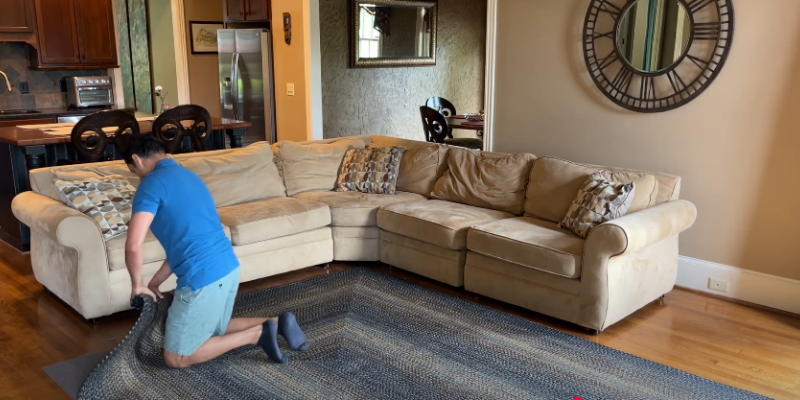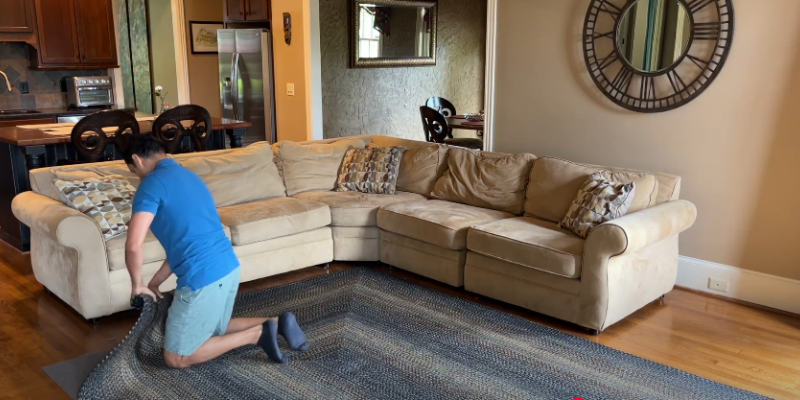Rugs are indeed a beautiful addition to the interior space of many homes, but there is one major problem that many people face: creases. Different factors can cause these creases, possibly because of the shipping or storage or even the wearing out of the rug. Usually, when any creases show on the rug, the problem is not just cosmetic, as it becomes hard to walk on the rug itself. It is crucial to keep the rug in its proper place without it being bunched up so as not to spoil the tidy and welcoming appearance of the room.
If you have purchased a new rug recently or already have one that has creases, relax; there is no need to panic! In today’s article, we will teach you practical and easy techniques that will help you get rid of those awkward folds and bring back the smooth texture of the rug.
Understanding the Causes of Rug Creases
Rugs may develop creases due to various factors. Each of these factors can help one in knowing what steps to take and remove the folds.
Natural Causes
Effects of Temperature Variations on Materials
Most rugs, especially those made of materials with a natural structure and texture, such as wool or cotton, tend to stretch or shrink whenever the temperature changes. For example, in winter the rug may get smaller in size due to the extremely cold temperatures, whereas in summer it may expand due to the high temperatures. This eventually leads to the development of creases after some time.
Folding During Shipping or Storage
In some cases, rugs are placed in boxes folded rather than rolled. This may result in the creation of unpleasant, sharp creases that will take a while to straighten out. Even when the rugs are rolled, they can still be folded, and due to pressure in transit, they can cause crease lines across the folds.
Synthetic Materials
Prone to Creasing
Synthetic rugs made from materials such as polyester or polypropylene are generally more susceptible to folding. This is because manmade fibers generally have low stretchability and recoverability in contrast to natural fiber rugs.
Lack of resilience
Wool and cotton, for instance, can bounce back after being creased, which is not the case with synthetic fibers. This results in creases that are quite often more persistent and difficult to get rid of.
Preparing Your Rug for Treatment
Before starting the procedure of removing creases, make the necessary arrangements for your rug first. This will make the whole process much simpler and more efficient.
Unrolling and Flattening
Lay the rug flat.
The first and simplest step you can take is to simply place the rug in the room where you can leave it flat. Let it relax by itself for a day or two. Many times, this alone is enough to take out some of the creases on it. In case you are not in a hurry, then this technique may work like a miracle without any additional measures.
Use heavy objects.
To remove stubborn creases, place heavy objects, such as books, on the rug. Just place the books or any other heavy items (like pieces of furniture) over the creases and let it sit for a couple of days. This will help in applying soft pressure, encouraging the fibers to settle down and stretch out.
Steam Treatment
Using Steam
One of the best methods for getting rid of folds in rugs is steaming, as the heat will help the fabric to relax. You can use a handheld steamer or an iron with a steam function at the affected areas. Avoid excessive heating, especially in the case of synthetic rugs where the material may get ruined.
Handheld Steamer or Iron
If you are using a handheld or steam iron, keep it a few inches away from the rug to avoid direct contact. Steam the entire creased area slowly and evenly. Once steamed, please allow the rug to rest and cool down before walking on it or putting any furniture on top of it.
Techniques for Removing Creases
Now that your rug is ready, let’s move on to learning about some practical methods to eliminate those annoying creases.
Reverse Rolling Method
-
Rolling in the opposite direction
One easy example of removing the creases is to roll the rags on the opposite side of the creases. For example, if the creases have formed on the length of the rug, it should be rolled in the reverse position, that is, the width of the rug. Keep it rolled for a couple of days, and that should ease the fibers and help them settle. -
Leave it Rolled
After rolling it in reverse, leave the rug rolled up for at least 24-48 hours. Once unrolled, the rug should appear much smoother, with fewer creases.
Stretching
-
Stretch the Rug
Another useful trick is to carefully pull the rug in the opposite direction of the folds. If you have a rug stretcher, that will be the best-case scenario, but you can also do it manually by hand by simply pulling and holding the rug for a few minutes at a time. -
Use Rug Stretcher
In case hand stretching is not that effective, it is recommended to get a rug stretcher and use it to apply even pressure so that the creases can be flattened.
Additional Tips for Stubborn Creases
In certain situations, and this is very rare, even after everything, the lines may still remain. If you have trouble with the stubborn lines, here are a few more suggestions that you can try.
Humidification
-
Increase Humidity
If the air in a house is too dry, the fibers in the rug may harden, which causes difficulties in removing creases from the rug. In that case, a humidifier can be placed, or a slightly moist (not soaking) fabric can be kept under the rug for some time. This helps loosen the fibers, making it easier to flatten the fabric and get rid of the creases. -
Damp Cloth Method
Take a moist piece of cloth and place it underneath the rug, especially on the sections that have creases. As the moisture of the cloth rises through the fibers, it will soften them and help in getting rid of the creases.
Professional Cleaning
-
Specialized Equipment
If all else fails, consider taking your rug to a professional cleaner. Professionals have specialized equipment that can remove even the most stubborn creases from rugs, especially those made from delicate or expensive materials. -
Seek professional help.
This option is particularly useful for antique rugs or rugs made from delicate fibers that could easily be damaged by DIY methods. A professional can assess the rug's material and choose the safest and most effective method to remove creases without causing harm.
Conclusion
Removing creases from rugs may require some time and patience, but the good part is that the majority of the creases are not permanent and can be worked on using the appropriate methods. Be it steam treatment, weighted placement, or simply rolling it backward, these techniques serve to bring the rug back to its unscathed state free of any crease.
Also note: take care of your rug; these techniques will help put the rug back in its original state. If you have an expensive or fragile rug, don’t hesitate to get help from a specialist. With these some easy tips, you will have a flat, pretty rug that will complement the aesthetics of the interior of your home. To buy flat and beautiful braided rugs for your home visit Homespice













